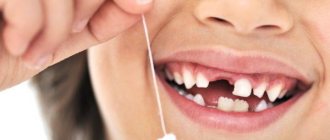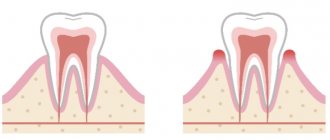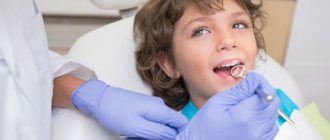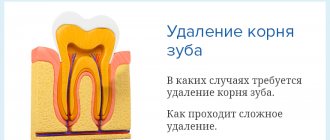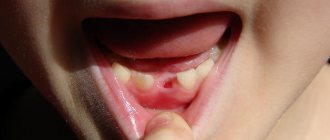How many teeth should a child have?
By the age of three, a child usually already has a full set of twenty primary teeth, and until about 6 years old, their number remains unchanged. Adolescents aged 13 to 18 years should normally have from 28 to 32 molars (depending on the presence of eights, which may erupt after 21 years or not appear at all).
Crowding of teeth and malocclusion
Due to the fact that there is usually not enough space for a growing wisdom tooth, it begins to prop up the adjacent molar and shift it towards the center, and it, in turn, also moves towards the center of the teeth adjacent to it. As a result, crowding of teeth occurs and their correct alignment is disrupted. If this process goes too far, the bite may be disrupted.
Pressure on the adjacent tooth
Quite often, as wisdom teeth grow, pain may occur (constant dull or intermittent), radiating to the ear, temple or lower jaw. If there are no external signs of inflammation (redness and swelling of the gums), then you need to take a photo of the tooth. After all, this is the only way to understand whether the wisdom tooth is growing correctly and whether it will be necessary to remove it.
Inflammation of the branches of the trigeminal nerve
The pathology is manifested by attacks of pain in the neck, as well as twitching of some muscles. Painful attacks can be triggered by normal daily activities such as washing, brushing teeth or shaving. Most often, the symptoms go away after the wisdom tooth is removed and proper anti-inflammatory treatment is administered.
Jaw cyst
Since the growth of a wisdom tooth occurs very slowly, it can cause the formation of a cyst in the lower jaw. In the event that the cyst does not grow, the course of the disease may be asymptomatic, and the cyst can be discovered by chance when a picture of the jaw is taken for completely different reasons. If the cyst grows, this causes pain in the area of the wisdom tooth. There may be an accumulation of fluid in the cyst, which will gradually corrode the walls of the teeth. If an infection gets into the cyst cavity, a gumboil (ulcer) of the wisdom tooth occurs. In this case, you can definitely answer that the “eight” must be removed.
What teeth appear first in children?
The rudiments of baby teeth and even some molars begin to form at the stage of intrauterine development, so modern diagnostic technologies make it possible to track this process and prevent some deviations. After birth, the first teeth usually begin to erupt when the baby reaches six months of age. This means he will soon be ready to eat more solid foods. In the vast majority of cases, the incisors appear first: as a rule, the lower central incisor becomes the “pioneer”.
Child's front teeth
Since a child’s front teeth usually erupt earlier than the rest, they can be used to track how the baby’s body tolerates this process. It can occur in different ways: some children are practically not worried, while others, on the contrary, experience stress and discomfort. Swelling of the gums at the site of the future tooth, itching and pain, as well as a slight increase in temperature are the main negative aspects associated with the appearance of the first teeth. When teething baby molars, children may experience runny nose and cough.
Why do people need wisdom teeth?
As you know, in nature there is nothing superfluous. Although wisdom teeth are considered to be vestiges (parts of the body that have lost their function during the process of evolution), they can often be necessary in old age. The eighth teeth can serve as a support for bridge prosthetics, and also partially take over the chewing function if, for some reason, it becomes necessary to remove adjacent teeth. If wisdom teeth are healthy and correctly positioned, then they perfectly complement the dentition. But very often, “eights” can cause problems, because many complications arise during their eruption.
How do children's teeth grow?
There is no need to panic if the child’s teeth growth does not fit into the above scheme. A delay of 1 - 3 months is considered normal and is associated with the individual characteristics of the body. Children under one year of age often have teeth that do not appear on schedule or may not appear at all. In the latter case, you need to contact your dentist who will help identify the cause.
How painful is wisdom teeth removal?
The question of the pain of wisdom tooth removal arises in all patients who need such an operation. The removal procedure is carried out under local anesthesia (various painkillers are used - ultracaine, septanest, ubistezin and others). The complexity of removal and pain depend on many factors: the structural features of the root system, the location of the tooth, the presence of complications in the form of cysts, suppuration and others, as well as the pain sensitivity threshold of a particular person.
What to do if your wisdom tooth hurts during pregnancy
Unfortunately, any pregnant woman may experience various unpleasant conditions and diseases. As with any other period, the eruption of wisdom teeth can occur during pregnancy and this can be a cause for concern. Many people wonder whether wisdom teeth can be treated during this period and how to deal with pain relief during this period. Gynecologists advise treating teeth (including “eights”) after the 16th week of pregnancy. It is during this period that all systems and organs of the fetus are already formed, so the use of painkillers will not negatively affect the child.
Folk remedies used to treat wisdom teeth
The following traditional medicine recipes will help reduce signs of gum inflammation and make teething less painful:
- The most common and simple method is rinsing the mouth with solutions of oak bark, sage, chamomile or soda solution.
- The inflamed gum above the figure eight can be lubricated with sea buckthorn oil.
- Rinsing the mouth with a decoction of chicory root. It has analgesic and anti-inflammatory effects. Add 1 tablespoon of chopped chicory root to 250 ml of boiling water and boil it all for 5 minutes. Then the broth is infused for 1 hour, after which you can use it to rinse the mouth 3-4 times a day.
- A saline solution with camphor and ammonia will have an analgesic effect. To prepare it, add 1 tablespoon of sea or table salt, 100 g of 10% ammonia and 10 g of camphor alcohol to 1 liter of cool boiled water. Shake everything well, then apply a cotton ball dipped in it to the teething site for 10-15 minutes. The procedure can be repeated several times a day.
Do not forget that any traditional medicine methods can only provide short-term relief, so do not hesitate to visit a dentist. Only a specialist will be able to answer you whether the wisdom tooth is growing correctly or not and whether there is a need for its removal.
Tooth growth abnormalities in children
Unfortunately, the development and growth of teeth in children does not always occur as expected: there are a number of anomalies of various types that in one way or another affect the aesthetics and/or functionality of the teeth.
Causes of impaired growth and development of teeth:
- bad heredity;
- fetal injury during pregnancy or birth; intrauterine growth retardation, infections and so on;
- disruption of the endocrine system, thyroid dysfunction;
- lack of vitamins and minerals;
- mechanical, thermal and chemical injuries to teeth;
- bad habits in children that can affect the formation of teeth;
- lack of proper hygiene and poor diet.
Below is a table that describes the most common types of dental anomalies in children.
| Anomaly class | Description |
| Size of teeth | There are microdentia (too small teeth) and macrodentia (too large teeth). The anomaly can affect one or several teeth (and even the entire dentition). |
| Number of teeth | There is partial (lack of several teeth) and complete (absence of all teeth) adentia. Hyperdentia is a supernumerary set of teeth (usually in the second row). |
| Shape of teeth | Cone-shaped, barrel-shaped (Hutchinson's teeth), Pflueger's teeth (the neck is more developed than the coronal part). |
| Anomalies in the structure of enamel and dentin | Hypoplasia (spots and grooves on the body of the tooth), hyperplasia (tubercles, enamel drops, etc.), dentinogenesis imperfecta (violation of the structure and color of dentin). |
| Color irregularities | Enamel pigmentation (gray, black, amber enamel color). Most often it is caused by a disruption of the immune system during the prenatal stage of development. |
| Malocclusion | All types of dental malocclusions: mesial, cross, open, deep and so on. |
Despite the fact that some dental anomalies in children are quite serious, a timely visit to the dentist will help you avoid problems and maintain the health and beauty of your smile. If you let the situation take its course, unpleasant consequences will not keep you waiting.
Main means and rules of care
A toothbrush and toothpaste are the main tools for caring for a child’s oral cavity. They should be chosen with great care.
How to choose a toothbrush
A common mistake is choosing a brush with too stiff bristles. Do not buy these so as not to injure the delicate gums and developing enamel of the child’s teeth. The bristles should be soft or medium soft, the brush head should be small. It would be good if the brush had a non-slip handle. Be sure to teach your child the correct cleaning technique - the movements should be sweeping, from top to bottom on the upper jaw and from bottom to top on the lower jaw. Movements from left to right not only leave uncleaned plaque on the teeth, but also damage the enamel.
A manual brush cleans plaque no worse than an electric one, but only if the cleaning technique is perfect. In addition, electric brushes, due to their bright design and unusual design, are more popular with children; with their help, it is easier to instill a love for oral hygiene. Remember that until around age 11, when your child's motor skills are fully developed, you still need to supervise his brushing.
How to choose toothpaste
Buy pastes containing strengthening components: hydroxyapatite, calcium or fluorine. They will help strengthen the enamel and prevent the development of caries. The optimal concentration of fluorides in the paste is up to 900 ppm (that is, 900 parts per million). Pastes with higher concentrations are used only in courses and as prescribed by a doctor. Remineralizing gels will provide excellent additional protection against caries.
Biorepair Junior toothpaste with mint flavor (from 6 to 12 years)
Tooth gel GC Tooth Mousse Multifruit
Gel for strengthening teeth ROCS (ROCS) Medical Minerals with fruit flavor…
Do not buy toothpastes with a high index of abrasiveness (RDA) - they polish and brighten teeth, but can damage the enamel. Pastes with an abrasiveness of up to 50 RDA are suitable for teenagers; this is enough for gentle cleansing. For whitening, it is better to choose toothpastes with natural enzymes (bromelain and papain). Pastes should not contain parabens or foaming agents (SLS, SLES).
Additional tools
Additional, but no less important components of care are dental floss and an irrigator (its use is mandatory if the child wears braces). With the help of these tools, the child will be able to thoroughly clean the interdental spaces that no brush can handle, even with the perfect cleaning technique. It is also a good idea to use rinses or special foams. They are convenient to use when it is not possible to brush your teeth, for example, at school or while traveling.
The natural sweetener xylitol will be a good helper in caring for your child’s teeth. It is added not only to candies and chewing gum, which can usefully replace regular ones, but also to toothpastes. The xylitol in their composition helps fight cariogenic bacteria and also takes care of the gums.
Chewing gum miradent Xylitol For Kids apple
Lollipops miradent Xylitol Drops mint
Chewing gum The Humble Co. Tropical Fruits
Fuzzy Rock Xylitol Crystals, Sugar Free, Peach Flavor
